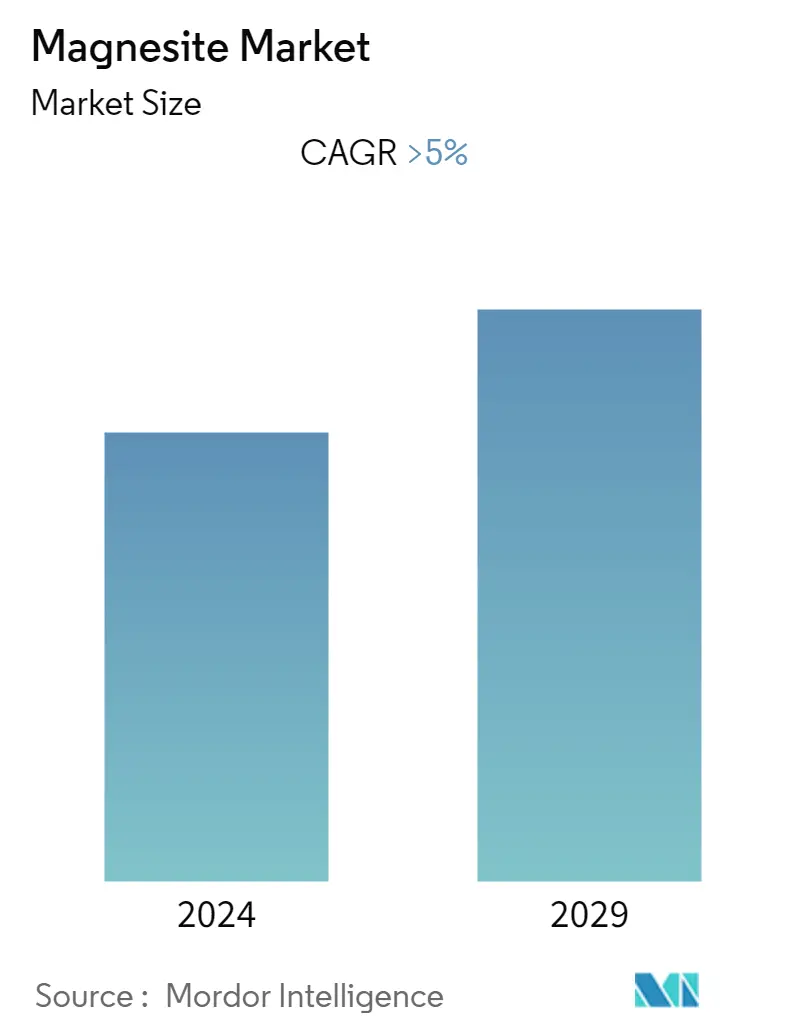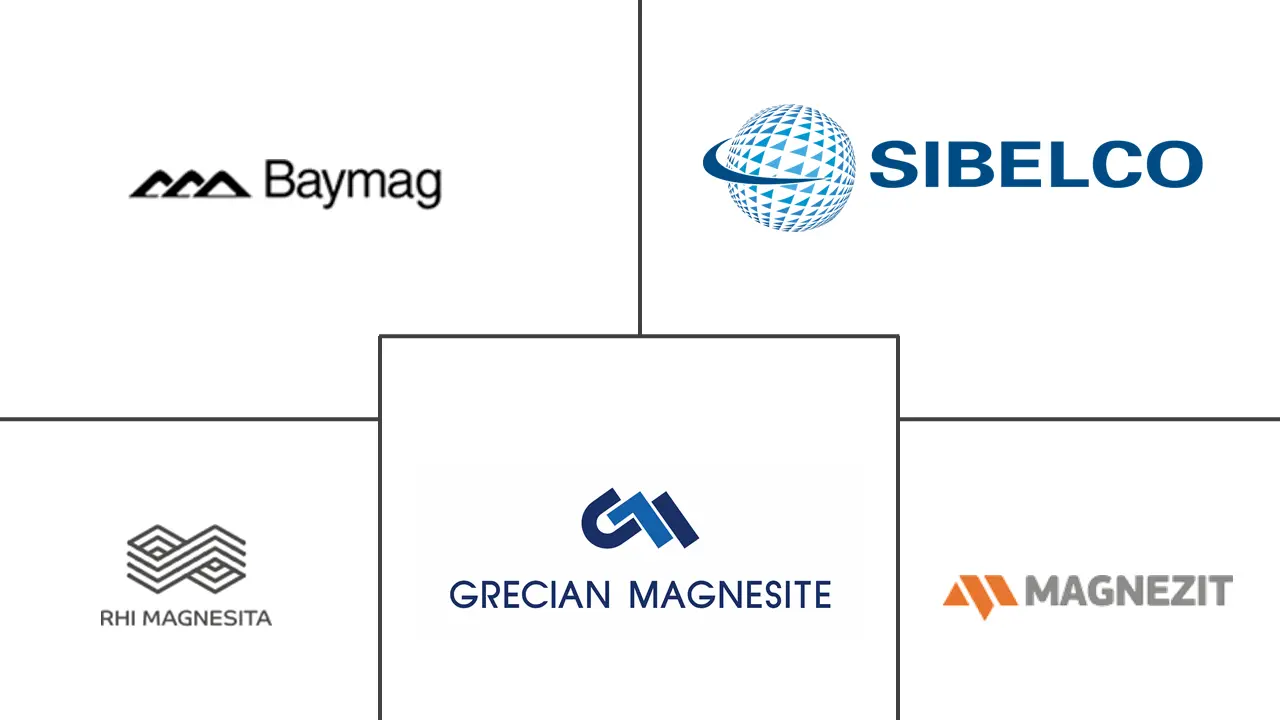Market Size of Magnesite Industry

| Study Period | 2019 - 2029 |
| Base Year For Estimation | 2023 |
| CAGR | 5.00 % |
| Fastest Growing Market | Asia Pacific |
| Largest Market | Asia Pacific |
| Market Concentration | High |
Major Players
*Disclaimer: Major Players sorted in no particular order |
Magnesite Market Analysis
The magnesite market is projected to register a CAGR of over 5% during the forecast period.
- The impact of the COVID-19 pandemic results in lower mining activities. The shutdown of the mining sector due to social distancing and other factors highly reduced the mineral's production levels, which, as a result, were unable to meet the demand. This factor constrained the overall mining sector and, thus, negatively impacted the overall market in terms of production. However, in the post-COVID-19 recovery, the market will likely grow for the rest of the forecast period, majorly owing to the expansion of the chemical, agriculture, and construction industries worldwide.
- In the short term, the increasing demand from construction and refractory industries is driving the market growth.
- However, stringent government regulations imposed on the production of magnesite are responsible for the hindered growth of the market.
- Using reliable and consistent renewable energy sources for mining provides an opportunity for the market's growth.
- In addition, Asia-Pacific is likely to dominate the overall market due to rising demand from the construction sector.
Magnesite Industry Segmentation
Magnesite is a magnesium carbonate mineral with MgCO3 as its chemical formula. Magnesite is used to produce magnesium oxide (MgO), which is further used in the steel industry as a refractory material and as a raw material in the chemical industry. Magnesite is also used as a gem and lapidary stone in small quantities. The market is segmented by type, application, and geography. By product type, the market is segmented into dead-burned magnesia, fused magnesia, and other types. By application, the market is segmented into agriculture, chemical, construction, refractory, and other applications. The report also covers the market size and forecasts for the magnesite market in 15 countries across major regions. For each segment, the market sizing and forecasts have been done based on volume (kilo tons).
| Type | |
| Dead-Burned Magnesia | |
| Fused Magnesia | |
| Other Types |
| Application | |
| Agriculture | |
| Chemical | |
| Construction | |
| Refractory | |
| Other Applications |
| Geography | |||||||
| |||||||
| |||||||
| |||||||
| |||||||
|
Magnesite Market Size Summary
The magnesite market is anticipated to experience steady growth over the forecast period, driven by the recovery from the COVID-19 pandemic's impact on mining activities. The pandemic led to reduced production levels due to global lockdowns, affecting the supply-demand dynamics. However, the market is expected to rebound, supported by the expanding chemical, agriculture, and construction industries worldwide. The construction sector, in particular, is a significant consumer of magnesite, utilizing it for various applications such as industrial floors, building boards, and road construction. Despite the positive outlook, the market faces challenges from stringent government regulations on magnesite production, which could hinder growth. Nonetheless, the adoption of renewable energy sources for mining presents a potential opportunity for market expansion.
Asia-Pacific is projected to dominate the magnesite market, largely due to the robust construction and chemical sectors in China, along with ongoing investments in agriculture. The region's growing construction market is driving demand for ceramics, particularly in residential and industrial sectors, while increasing road construction activities in developing areas further boost magnesite consumption. The market is partially consolidated, with major players like Grecian Magnesite and RHI Magnesita GmbH holding significant market shares. These companies continue to enhance their operations, as seen in Grecian Magnesite's renewal of its quality management certification and the expansion of mineral processing capabilities by its Turkish subsidiary. Despite challenges such as labor shortages and supply chain issues, the market is poised for growth, particularly in the post-COVID-19 recovery phase.
Magnesite Market Size - Table of Contents
-
1. MARKET DYNAMICS
-
1.1 Drivers
-
1.1.1 Increasing Demand from Refractory Industries
-
1.1.2 Other Drivers
-
-
1.2 Restraints
-
1.2.1 Stringent Government Regulations
-
1.2.2 Impact of COVID-19
-
-
1.3 Industry Value Chain Analysis
-
1.4 Porter's Five Forces Analysis
-
1.4.1 Bargaining Power of Suppliers
-
1.4.2 Bargaining Power of Consumers
-
1.4.3 Threat of New Entrants
-
1.4.4 Threat of Substitute Products and Services
-
1.4.5 Degree of Competition
-
-
-
2. MARKET SEGMENTATION (Market in Volume)
-
2.1 Type
-
2.1.1 Dead-Burned Magnesia
-
2.1.2 Fused Magnesia
-
2.1.3 Other Types
-
-
2.2 Application
-
2.2.1 Agriculture
-
2.2.2 Chemical
-
2.2.3 Construction
-
2.2.4 Refractory
-
2.2.5 Other Applications
-
-
2.3 Geography
-
2.3.1 Asia-Pacific
-
2.3.1.1 China
-
2.3.1.2 India
-
2.3.1.3 Japan
-
2.3.1.4 South Korea
-
2.3.1.5 Rest of Asia-Pacific
-
-
2.3.2 North America
-
2.3.2.1 United States
-
2.3.2.2 Canada
-
2.3.2.3 Mexico
-
-
2.3.3 Europe
-
2.3.3.1 Germany
-
2.3.3.2 United Kingdom
-
2.3.3.3 France
-
2.3.3.4 Italy
-
2.3.3.5 Rest of Europe
-
-
2.3.4 South America
-
2.3.4.1 Brazil
-
2.3.4.2 Argentina
-
2.3.4.3 Rest of South America
-
-
2.3.5 Middle-East and Africa
-
2.3.5.1 Saudi Arabia
-
2.3.5.2 South Africa
-
2.3.5.3 Rest of Middle-East and Africa
-
-
-
Magnesite Market Size FAQs
What is the current Magnesite Market size?
The Magnesite Market is projected to register a CAGR of greater than 5% during the forecast period (2024-2029)
Who are the key players in Magnesite Market?
Grecian Magnesite , Sibelco Australia Limited, Baymag, RHI Magnesita GmbH and Magnezit Group are the major companies operating in the Magnesite Market.

